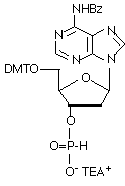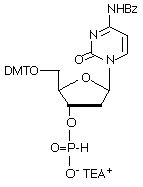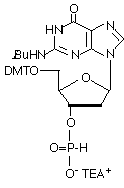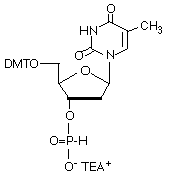|
e-oligos: Phosphonate Oligos
Phosphonate Oligos
|
Phosphonate
Oligos. $/base* |
| 1
micromolar Scale |
$40/base |
|
*minimum
charges for 20 mer applies |
H-Phosphate Chemistry
H-phosphonate chemistry is of value when the internucleotide linakge required is other than the standard phosphodiester linkage.
The H-phosphonate monomers shown below are used instead of the phosphoramidite bases. Using this method, the monomer that is able to be
activated is a 5'-DMT-base-protected, nucleoside 3'-hydrogen phosphonate. The presence of the H-
phosphonate moiety on these monomers renders phosphate protection unnecessary. The same base protecting
groups are used in phosphite triester chemistry. The H-phosphate synthesis cycle is very similar to that of the phosphoramidite method.
Slight differences result from the properties of the monomers utilized.
For instance, a different activating agent is used. In addition, the H-phosphonate diesteres generated by the coupling reactions are stable to the normal
reaction conditions, so oxidation at every step is unnecessary. Instead, a single oxidation step can be performed at the end of the chain elongation.
This single oxidation step makes it easy to produce modified DNA. For instance, if a sulfur containing compound is used as the
oxidizing agent, all of the internucleotide bonds will then contain sulphur instead if oxygen attached to the phosphorous atom. The most popular use of this chemistry
is for the radioactive labeling of all phosphodiester linkages to phosphorothioate by using radioactive sulfur.
The Support
H-Phosphonate synthesis uses the same supports as does the ▀-cyanoethyl phosphoramidite chemistry.
The Monomers
The H-Phosphonate monomers are protected at the 5'-hydroxyl position with dimethoxytrityl groups.
The exocyclic amines on the bases are protected by the same groups as in the ▀-cyanoethyl phosphoramidite analogues. The phosphonate group is attached to the 3' position.
|
|
|
 |
|
 |
|
dA-H-Phosphonate |
|
dC-H-Phosphonate |
|
|
|
|
|
|
 |
|
 |
|
dG-H-Phosphonate |
|
dT-H-Phosphonate |
|
|
|
Detritylation
This process is the same as in the ▀-cyanoethyl phosphoramidite procedure.
Neutralization
Residual DCA from the detritylation step is neutralized with a solution of pyridine in acetonitrile. This step also provides the proper solvent medium for the coupling reaction.
Coupling
After detritylation and neutralization, the next protected H-phosphonate is delivered to the reaction column.
Adamantoyl carboxyl acid chloride is used to activate the phosphonate by the addition of the adamantoyl moiety to the free oxygen of the H-phosphonate.
The coupling mechanism is a nucleophilic attack by the free 5'-hydroxyl group on the phosphorous of the incoming activated monomer. For this reason, it is important that the environment be hydroxyl-free.
The phosphonate diester linkages generated by this coupling are stable. Therefore, oxidation is performed at the end of the synthesis.
Cycling
Following the coupling step, the cycle of reactions is repeated, beginning with the detritylation step, until chain elongation is complete.
Oxidation
Oxidation step is normally omitted during cyclic chain elongation and a single oxidation is performed later with the required oxidizer.
In the oxidation step, the hydrogen atom which is bound to the phosphorous is replaced with an oxygen atom.
Oxidation is accomplished with a mixture of two solutions. One solution contains iodine in tetrahydrofuran (THF), and the other N-methylmorpholine in water and THF.
If required, the DNA can be modified at this step. For instance, phosphorothioates are generated by oxidizing with a sulphur-containing solution.
Final Detritylation
Regular detritylation cycle is used unless reverse phase purification is required. Final DMT should be kept 'ON' for purification by reverse phase cartridge or HPLC, .
Purification
Purification by gel electrophoresis is recommended.
References:
1. Hall,R.H.,Todd,A.R., and Webb,R.F. (1957). Mixed anhydrides as intermediates in the synthesis of dinucleoside phosphates. J. Chem. Soc., 3291-3296.
2. Garegg,P.J., Regberg,T., Stawinski,J. and Stromberg,R. (1985). Formation of internucleotidic bonds via phosphonate intermediates. Chem. Scripta 25, 280-282.
3. Garegg,P.J., Regberg,T., Stawinski,J. and Stromberg,R. (1986). Nucleoside hydrogenphosphonates in oligonucleotide synthesis. Chem. Scripta 26, 59-62.
4. Garegg,P.J., Lidh,I.,Regberg,T., Stawinski,J. and Stromberg,R. (1986). Nucleoside H-phosphonates. Chemical synthesis of oligodeoxyribonucleotides by
the hydrogenphosphonate approach. Tetrahedron Lett. 27, 4051-4054.
5. Froehler,B.C., Ng,P.G., and Matteucci,M.D. (1986). Synthesis of DNA via deoxynucleoside H-phosphonate intermediates. Nucleic Acids Res. 14, 5399-5407.
6. Froehler,B.C., and Matteucci,M.D. (1986). Nucleoside H-phosphonates : Valuable intermediates in the synthesis of oligonucleotides. Tetrahedron Lett. 27, 469-472.
7. Froehler,B.C. (1986). Nucleoside H-phosphonates : Deoxyoligonucleotide H-phosphonate diester intermediates in the synthesis of internucleotide phosphate analogues. Tetrahedron Lett. 27, 5575-5578.
8. Andrus,A.,Efcavitch,J.W.,McBride,L.T., and Giusti,B. (1988). Novel activating and capping reagents for improved hydrogenphosphonate DNA synthesis. Tetrahedron Lett. 29, 861-864.
9. Seliger,H. and Roesch,R. (1990). Simultaneous synthesis of multiple oligonucleotides using nucleoside H-phosphonate intermediates. DNA and Cell Biol., 9, 691-696.
10. Stawinski,J.,Stromberg,R.,Thelin,M., and Westman,E.. (1988). Studies on the t-butyldimethyl-silyl group as 2'-O- protection in oligoribonucleotide synthesis
via the H-phosphonate approach. Nucl. Acids Res. 16, 9285-9288.
11. Stein,C.A.,Iversen,C.A.,Subashinge,C.,Cohen,J.S.,Stec,W.J. and Zon,G. (1990). Preparation of 35S-labeled polyphosphorothioate oligodeoxyribonucleotides by
the use of H-phosphonate chemistry. Analytical Biochem. 188, 11-16.

|
|
|

